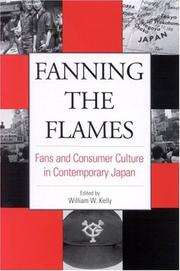| Listing 1 - 7 of 7 |
Sort by
|
Book
ISBN: 0674747259 1684172764 Year: 1990 Publisher: Cambridge Harvard university. Council on East Asian studies
Abstract | Keywords | Export | Availability | Bookmark
 Loading...
Loading...Choose an application
- Reference Manager
- EndNote
- RefWorks (Direct export to RefWorks)
Book
ISBN: 9781684172764 9780674747258 Year: 1990 Publisher: Boston Leiden;Boston Harvard University Asia Center BRILL
Abstract | Keywords | Export | Availability | Bookmark
 Loading...
Loading...Choose an application
- Reference Manager
- EndNote
- RefWorks (Direct export to RefWorks)
Book
ISBN: 9784768479728 4768479723 Year: 2018 Publisher: Tōkyō : Hakutakusha,
Abstract | Keywords | Export | Availability | Bookmark
 Loading...
Loading...Choose an application
- Reference Manager
- EndNote
- RefWorks (Direct export to RefWorks)
Rakugo. --- Japanese literature --- Ghost stories, Japanese. --- San'yūtei, Enchō,
Book
ISBN: 9781921867507 1921867507 Year: 2013 Publisher: Victoria Monash University
Abstract | Keywords | Export | Availability | Bookmark
 Loading...
Loading...Choose an application
- Reference Manager
- EndNote
- RefWorks (Direct export to RefWorks)
"Unique among foreigners in nineteenth-century Japan, Australian-born professional storyteller (rakugoka) Henry Black (1858-1923) enthralled audiences with his adaptations of novels by Charles Dickens, Mary Braddon and Fortuné de Boisgobey. These tales, later produced as books, brought notions of European modernity to many ordinary Japanese. Black also acted kabuki roles, managed an orchestra, performed magic and hypnotism, lived with his Japanese male lover, drank heavily, and practised tea ceremony. His voice was recorded for the London Gramophone Company on the first disc-shaped recordings made in Japan. In the 1870s Black had joined the pro-democracy movement, promoting equal rights and an elected assembly. His later affiliation with the San'yū guild of storytellers, under the professional name of Kairakutei Burakku, enabled him to promote the movement's aims through his stories. He became a naturalised Japanese, and was shunned by his own family. This is the first full-length English-language account of Henry Black. Translating Black's narrated adaptations and drawing on newspapers and diary entries, Ian McArthur demonstrates Black's individual contribution to the modernisation of Meiji-era (1868-1912) Japan"--Publisher's description.
Rakugo --- Storytellers --- Kabuki --- Kairakutei, Burakku, --- Japan --- Social life and customs --- History
Book
ISBN: 9784796703871 479670387X Year: 2020 Publisher: 東京 せりか書房
Abstract | Keywords | Export | Availability | Bookmark
 Loading...
Loading...Choose an application
- Reference Manager
- EndNote
- RefWorks (Direct export to RefWorks)
Book
ISBN: 110891747X 1108913148 1108912699 1108831508 Year: 2021 Publisher: Cambridge : Cambridge University Press,
Abstract | Keywords | Export | Availability | Bookmark
 Loading...
Loading...Choose an application
- Reference Manager
- EndNote
- RefWorks (Direct export to RefWorks)
Rakugo, a popular form of comic storytelling, has played a major role in Japanese culture and society. Developed during the Edo (1600-1868) and Meiji (1868-1912) periods, it is still popular today, with many contemporary Japanese comedians having originally trained as rakugo artists. Rakugo is divided into two distinct strands, the Tokyo tradition and the Osaka tradition, with the latter having previously been largely overlooked. This pioneering study of the Kamigata (Osaka) rakugo tradition presents the first complete English translation of five classic rakugo stories, and offers a history of comic storytelling in Kamigata (modern Kansai, Kinki) from the seventeenth century to the present day. Considering the art in terms of gender, literature, performance, and society, this volume grounds Kamigata rakugo in its distinct cultural context and sheds light on the 'other' rakugo for students and scholars of Japanese culture and history.
Rakugo --- Literature and society --- Storytelling --- History and criticism. --- Otoshibanashi --- Japanese wit and humor --- Story-telling --- Telling of stories --- Oral interpretation --- Children's stories --- Folklore --- Oral interpretation of fiction --- Literature --- Literature and sociology --- Society and literature --- Sociology and literature --- Sociolinguistics --- Performance --- Social aspects

ISBN: 0791460320 0791460312 Year: 2004 Volume: *1 Publisher: Albany State University of New York Press
Abstract | Keywords | Export | Availability | Bookmark
 Loading...
Loading...Choose an application
- Reference Manager
- EndNote
- RefWorks (Direct export to RefWorks)
Culture populaire --- Culture de masse --- J4143 --- J6700 --- J6955 --- J6975 --- J6843.10 --- Popular culture --- Culture, Popular --- Mass culture --- Pop culture --- Popular arts --- Communication --- Intellectual life --- Mass society --- Recreation --- Japan: Sociology and anthropology -- cultural trends and movements -- popular culture --- Japan: Performing arts and entertainment -- music --- Japan: Sports and recreation -- baseball, softball --- Japan: Sports and recreation -- martial arts, fighting sports -- sumō, wrestling --- Japan: Performing arts and entertainment -- variety entertainments -- story telling, comic talks and stand-up (rakugo, manzai) --- history --- -20th century. --- History --- Culture
| Listing 1 - 7 of 7 |
Sort by
|

 Search
Search Feedback
Feedback About UniCat
About UniCat  Help
Help News
News